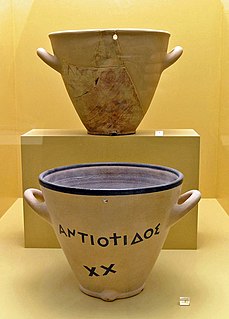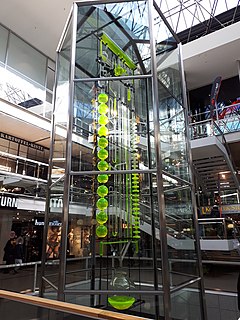 W
WA water clock or clepsydra is any timepiece by which time is measured by the regulated flow of liquid into or out from a vessel, and where the amount is then measured.
 W
WThe Aqua Horological Tintinnabulator (also known as the Victoria Centre Clock or the Emett Clock or The Time Fountain is a 'water-powered' clock. From 1973 to 2010 it was installed on the ground floor at the Victoria Centre in Nottingham, England. In 2015 it was reinstalled in the shopping centre on the first floor.
 W
WThe Borugak Jagyeongnu, classified as a scientific instrument, is the 229th National Treasure of South Korea and was designated by the South Korean government on March 3, 1985. The water clock is currently held and managed by the National Palace Museum of Korea in Seoul. It dates to the time of King SeoJong of the Joseon Dynasty.
 W
WThe Clock of Flowing Time is a 13 meter high water clock extending over three floors in the Berlin Europa-Center. The clock was designed by the French artist Bernard Gitton and set up in 1982.
 W
WThe elephant clock was a medieval invention by Ismail al-Jazari (1136–1206), an engineer and inventor of various clocks. The device consisted of a weight powered water clock in the form of an Asian elephant. The various elements of the clock are in the housing (howdah) on top of the elephant. In China a clock escapement mechanism was invented by the polymath Buddhist monk Yi Xing. Hydraulically powered waterwheels and water clocks were also used in the mechanically driven and rotated equatorial armillary sphere of Zhang Heng and Ma Jun. The elephant clock had some design differences compared to earlier waterclocks.
 W
WThe Hornsby Water Clock, titled Man, Time and the Environment is a piece of kinetic sculpture, a decorative fountain and a functional clock in the Florence Street pedestrian mall in Hornsby, New South Wales, Australia. Unveiled in 1993, the sculpture was designed and engineered by Victor Cusack and constructed of bronze, stainless steel and glass by Victor and his foundry floor manager Rex Feakes. Construction, including alterations to the mall, cost over A$1 million and took two and half years; thereafter, chicken bones and other carelessly discarded items caused many breakdowns before the water filtration system was upgraded.
 W
WA hydrochronometer is a kind of water clock.
 W
WThe Jayrun Water Clock, a water clock built by the Muslim engineer Muhammad al-Sa'ati, was positioned at the gate of Damascus, Syria, at the exit of the Umayyad Mosque in the 12th century during the reign of Nur ad-Din Zangi.
 W
WThe Water Clock, also known as The Giant Water Clock, is in the permanent collection of The Children's Museum of Indianapolis located in Indianapolis, Indiana, United States. The modern water clock is located in the Sunburst Atrium of The Children's Museum, and is adjacent to the Grand Staircase leading up to the second floor. It was created by French scientist and artist Bernard Gitton in 1988, the same year that the museum acquired it.